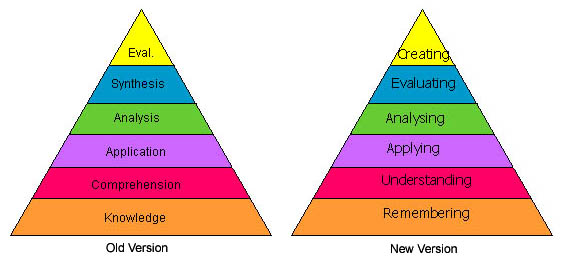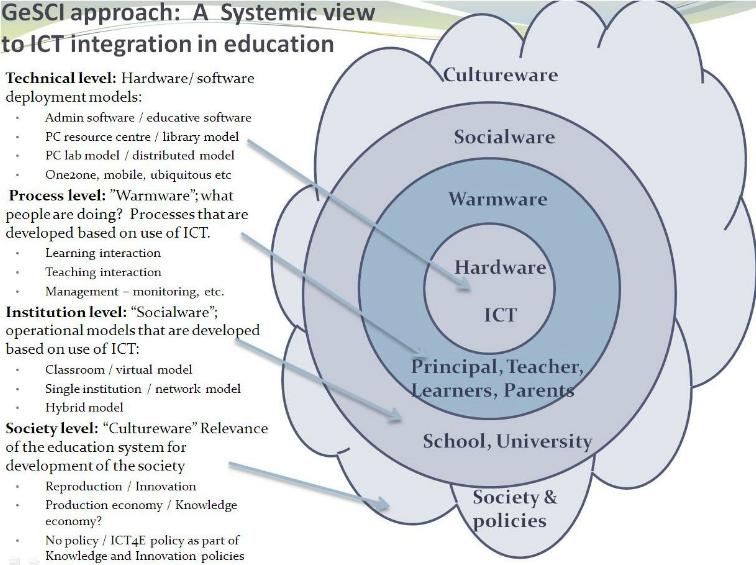Course:EDCP470 951 2010/ICT Integration
Technology cannot be integrated into classroom programs overnight. According to Sandholtz, Ringstaff, and Dwyer (1997), technology integration includes five stages: entry, adoption, adaptation, appropriation, and invention. Each stage has its own patterns of change and support requirements. (more)
Entry: Instruction is traditional, with teacher-directed activities. Some common instructional technologies include blackboards, text-books, workbooks, and overhead projectors. As they begin to use computer technologies in the traditional environment, teachers typically encounter problems such as resource management. Technical issues may be deanding. The support needed for educators at the entry phase includes providing time for planning with peers and opportunities for staff to share experiences with non participant colleagues (see Action Learning).
Adoption: When teachers move into the adoption phase, they begin to show more concern about how technology can be integrated into daily lesson plans. Traditional whole-group lecture and seat work still dominate instructional strategies. Nevertheless, technology is now being used to teach children how to use technology. Common activities include keyboarding, word-processing, or drill-and- practice activities. Teachers begin to anticipate problems and develop strategies to solve them. Although technical issues still exist, at this stage the teachers begin to perform basic trouble-shooting on their equipment such as fixing paper jams or changing the ink cartridge in the printer (Sandholtz et al., 1997). Technical support and training for computer-assisted-instruction and word-processing software are necessary at this stage (Dwyer, Ringstaff, & Sandholtz, 1990).
Adaptation to and integration of new technologies into traditional classroom practice occur. Lecture, seat work, and recitation continue to dominate classroom practice; however, during 30% to 40% of the school day, students use word processors, databases, some graphic programs, and computer-assisted-instruction packages (Sandholtz et al., 1997). Productivity is a major theme. Students produce more faster. Teachers have learned to use computers to save time rather than create additional demands. According to Dwyer et al. (1990), there are four support issues. First, encourage peer observation and team teaching, and develop a flexible schedule that permits these activities. Second, introduce and discuss alternative pedagogies. Third, because productivity is important at this stage, train staff to use such software tools as spreadsheets, databases, graphics, hypermedia, and e-mail. Fourth, introduce videodiscs and scanners.
Appropriation is more of a milestone than a phase. Personal appropriation of the technology tools by individual students and teachers is the catalyst to this change in technology use. Teachers' personal attitudes toward technology become the benchmark for this milestone in instructional evolution. Teachers understand technology's usefulness, and they apply it effortlessly as a tool to accomplish real work. More interactions between students are observed, and students work with computers frequently. There is evidence of project-based instruction, collaboration and co-operation, and creative schedules. At this milestone, encourage routine peer observations and group discussions. Discuss alternative assessments. Encourage professional growth through conferences and presentations. Finally, examine technology integration goals.
Invention. Teachers experiment with new instructional patterns and ways of relating to students and other teachers. They reflect on teaching and question old patterns of instruction. Teachers begin to see knowledge as something children must construct rather than something to be transferred. Interdisciplinary project-based instruction, team teaching, and individually paced instruction are hallmarks of this phase. Classroom interactions change. Student experts surface to assist their peers and teachers with technology. Students work together in more collaborative ways. To support teachers at this level, advocate collaboration between teachers and en-courage teachers to write about and publish their experiences. Create an on-going support system with others outside the district through e-mail and the Internet. Finally, integrators should share their knowledge by mentoring other teachers.
Reference: <http://www.educ.utas.edu.au/users/ilwebb/Research/ict_integration.htm>
This looks very similar to Bloom's taxonomy of learning

Jyrki Pulkkinen has created a contemporary systems model for ICT integration in the classroom.
http://un-gaid.ning.com/forum/topics/preliminary-conclusions-and-1
The following is a link to a great clip that demonstrates what ICT literacy integration might look like for teachers in the classroom:
